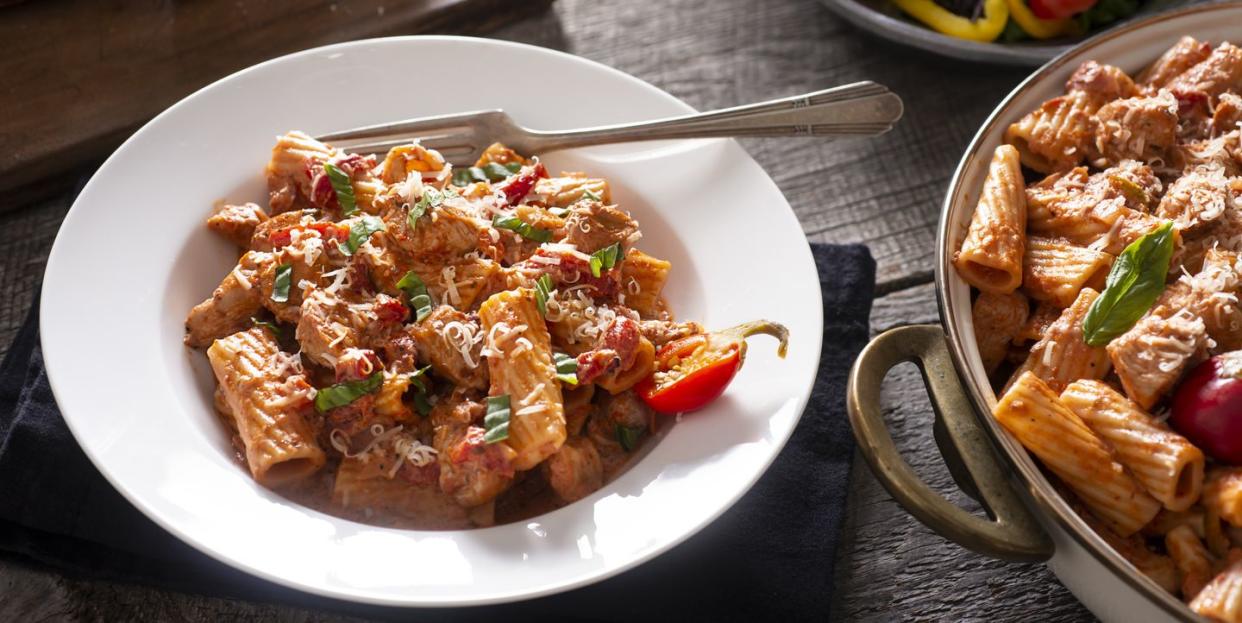Should You Ditch Your Beloved Pasta for Bean-Based Alternatives?

Scan the pasta aisle these days, and you’ll notice some new noodle choices made from ingredients such as black beans, chickpeas, lentils, vegetables like cauliflower, or some combination of all. These options bill themselves as being packed with protein and fiber and often lower in carbohydrate, so they seem pretty wholesome. But are they really a better choice than your trusty wheat-based pasta?
With all the hype around grain-free and low-carb diets, you might assume the answer is yes. But before you say goodbye to your standard spaghetti for good, let’s take a look at the facts.
We tapped Georgie Fear, R.D., C.S.S.D., and Alissa Rumsey, M.S., R.D., for the nutritional pros and cons of lentil, chickpea, and bean pastas and whether you should pick them over ones made from wheat.
The Claim:
Pastas made from beans or legumes are a healthier choice than their wheat-based counterparts.
The Evidence:
Alternative pastas aren’t exactly new. Noodles made from gluten-free grains such as rice or quinoa have been around for years, and experts agree that they don’t offer much of a nutritional benefit over wheat pastas for most folks. (Unless you have a medical reason to avoid gluten, of course.)
Bean-based pastas are usually gluten-free, too, but nutritionally speaking, they’re a very different story. Since they’re made from whole chickpeas, lentils, black beans, or other beans or legumes, they tend to boast a pretty impressive nutritional profile.
A 3.5-ounce serving of chickpea pasta, for instance, has
340 calories
6g fat
56g carbs
23g protein
8g fiber
35 percent of your daily iron
The same amount of regular white pasta has:
350 calories
2g fat
74g carbs
12g protein
5g fiber
17 percent of your daily iron
Both white and bean pastas offer plenty of carbohydrates. But pastas made with beans or legumes pack loads more fiber, and the extra roughage can be a good thing. Most of us don’t get enough fiber, and it can help you stay satisfied, Rumsey points out. And feeling more satisfied could potentially nix the urge to snack later on, which could make it easier to keep your weight in check. Plus, getting your fill of fiber could reduce your risk for heart disease, diabetes, and even some cancers.
That doesn’t mean bean pastas should always be the default choice for cyclists though. When it comes to fueling up for a long ride or a race, basic white pasta is a better choice.
“Unlike fiber, most of the carbs in white flour pasta are a digestible starch, which can be stored in your muscles as glycogen,” Fear says. White pasta is also less likely to mess with your stomach. “For a typical three-day carb load before an important race [or ride], white pasta would be the safer choice because you are likely to be eating a large amount of it, and you don’t want large amounts of dietary fiber potentially adding bathroom stops to your race,” she explains.
Where bean-based options have a clear edge? The protein department. “The extra protein is important to help with muscle and connective tissue repair, as well as for immune system maintenance,” Fear says. They’re also a good way to get in more iron, which can be especially beneficial for vegetarians and vegans who tend to get less compared to omnivores, notes Rumsey.
The Verdict:
White pasta is still the best choice for fueling up before an endurance event. “It will digest more quickly and allow your body to use that energy for your ride,” Rumsey says. Plus, the low fiber content means it won’t increase the risk for potential GI issues. It’s also good to turn to when you just need something that’ll be easy on your belly, like if you have a stomach bug, for example, Fear says.
[Gravel! prepares you with everything you need to know to crush it, including the best gear, how to train, and much more!]
But on non-training days or as a recovery meal, bean-based pastas can be a good option since they offer more vitamins, minerals, protein, and fiber than white pasta. And they can be especially helpful for folks who struggle to meet their iron needs, such as vegetarians or vegans. (If you’re worried that all the extra fiber might mess with your stomach, try doing half bean and half regular pasta at first to give your system some time to adjust.)
That’s not to say bean-based options have to replace all other types of pasta any time you aren’t fueling up for a hard workout. “You could use them in combination with white pasta, or just treat them as another plant-based option to add to your regular meal rotation,” Rumsey says.
You Might Also Like

